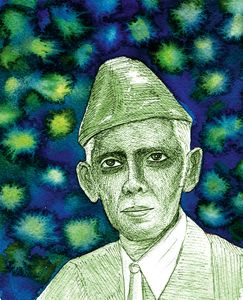In 1938, Muhammad Ali Jinnah was at the nadir of his quest to become the sole spokesman of the Muslims of India. In the first ever general elections [to 11 provincial assemblies] held the previous year, his party, the All India Muslim League, had received less than 5 per cent of the Muslim vote in the separate Muslim electorate. His meteoric rise over the next decade was still in an unseen future. The demand for Pakistan was still to be articulated through the 1940 Lahore Resolution. No one was calling him the ‘Quaid-e-Azam’ [great leader]. At this low point, he was invited to become a life member of the Aligarh Muslim University. In keeping with AMU tradition, his portrait was hung in the gallery that encircles the auditorium.
Some 18 years earlier, in 1920, when Gandhi was being hailed as the sole spokesman of all Indians, Hindu and Muslim, for having brought the two communities together in an unprecedented demonstration of communal amity and national unity, he was invited by AMU to become a life member. His portrait, too, was hung in the gallery.
It was Gandhi who took to calling his fellow AMU life member Jinnah the ‘Quaid-e-Azam’ to the point where yet another AMU life member, Maulana Azad (whose portrait, too, hangs in the gallery), asserted that it was Gandhiji calling Jinnah the ‘Quaid-e-Azam’ that really gave currency to the honorific. Jaswant Singh records that Jinnah repaid the courtesy by “extraordinarily departing from his usual practice” to refer to Gandhi as the “Mahatma”. Now, will the sangh parivar kindly take to the streets with their trishuls flailing to protest against the Father of the Nation?
When after partition, Nehru was made life member of AMU in January 1948, Jinnah’s portrait stared down at him as he made perhaps the most brilliant speech of his life urging those Muslims of India who had ignored Jinnah’s call to stay on as honoured citizens of India. Those who heeded Nehru’s call and their descendants now number almost as many as the citizens of the self-proclaimed Islamic Republic of Pakistan. In India at least, AMU life member Nehru triumphed over AMU life member Jinnah. What further revenge does the saffron tribe seek?
History also shows that the partition of India was really the partition of the Muslims of the subcontinent. It split the largest conglomeration of Muslims in the world into three mutually hostile nations, dividing and distorting the voice of 600 million Muslims. Given our 175 million Muslims, it is as impossible, in the 21st century, to think of India without Islam as it is to think of Islam without India. That is our pride and the negation of Jinnah’s pyrrhic victory. It is our secular triumph we should be celebrating, not targeting history or our minorities.
Also, would BJP MP Satish Gautam, who led the assault on AMU, like to see his communal counterparts in Pakistan remove the plaque at Lahore, which commemorates Mahatma Gandhi inaugurating the Gulab Devi Hospital, launched by Lala Lajpat Rai in his mother’s name? Does he know that when this demand was made in the aftermath of partition, Sir Syed Muratab Ali, chairman of the Gulab Devi Trust, refused, saying that removing the plaque would be tantamount to removing the headstone from a grave and he would not be a party to such dishonour? To this day, the plaque remains, the trust remains, and the name of the hospital remains unchanged.
Moreover, as the walls of Parliament are festooned with the annual photographs of members of the pre-Independence Central Legislative Assembly, replete with Leaguers who were in the forefront of the Pakistan movement, would the MP for Aligarh wish to summon his goons to gherao the speaker?
Aiyar is a former Union minister and social commentator.


